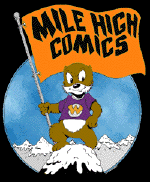A Discussion of Grading Standards
Near Mint/9.1-9.7
|
This week's column is a continuation of my series on comic book grading standards. As many of you already know, this topic came to the forefront after I recently discovered that the staff at Overstreet publications is presently accepting feedback on how to revise the comic book grading standards that they have had in place for the past 30 years. The reason they are planning this revision in their standards is a "negotiation" that is presently being held between the creators of THE OVERSTREET COMIC BOOK PRICE GUIDE and representative of Comics Guarantee LLC., the only company that presently provides third-party grading verification within the comics field. This has all come about because CGC has taken it upon themselves to implement more stringent standards in the higher grades (9.2-10.0) than the decades-old Overstreet standards. By their own admission, the Overstreet team is contemplating bowing to CGC's desires for a unified standard that more closely adheres to the CGC view of grading. My position on the matter is that I believe it is grossly unfair for the Overstreet team to change the grading rules that individual collectors have utilized to base their purchasing decisions for the the past 30 years. This unilateral revision has the potential to wipe out millions of dollars of accumulated value in private collections, while only benefiting CGC in the process. Moving on in my continuing discussion of grading standards, I want to delve this week into the specific criteria required for a comic to be classified as "Near Mint." In the 1992 edition of THE OVERSTREET GRADING GUIDE "Near Mint" was defined as any comic with a grade between 9.1-9.7. The following minor defects were specifically allowed in the photographs shown in this grade:
9.7
9.6
9.5
9.4
9.3 & 9.2
9.1 After you've read through this long listing of allowable defects in the Near Mint grade, it should be clear that the original Overstreet standards did not require comics in Near Mint to be anything close to perfect. In fact, in several instances, multiple defects were allowed on a single book without it falling out of the Near Mint category. The overriding considerations were that a comic book in Near Mint have "Only minor imperfections," and that it exhibit the characteristics of being "As if it were just purchased from the newsstand, and read once or twice." In my opinion, Overstreet got it right the first time. I am forever having to remind people that the first word in "Near Mint" is "Near." Near in this context means close to, but not exactly the same. As far as I'm concerned, that definition works quite well when grading comics. The vast majority of comics come from the printing plant with minor defects incurred long before they reach the ultimate consumer. Even the Edgar Church comics, which were read once (if at all...), and then stored in a dark closet for 35 years, exhibited some of the minor flaws listed above. Given the poor handling of comics at the printing plant, during the distribution process, and by indifferent store clerks, I think it is completely unrealistic to expect the vast majority of books will not have some minor flaws. Especially if they're more than 30 years old. That's why it's called "Near Mint." Yet CGC is very restrictive in what they will allow in the 9.4 category, and they very seldom allow comics to reach the "elite" status of 9.6. Actually, I believe that almost every new comic being printed would qualify as a 9.6 by Overstreet's 1992 standards, yet CGC has chosen to severely limit the number of issues they allow in the 9.6 category. The same is true of all the other grades above 9.2. Complicating this matter even further, it is infuriating that CGC will not publish an actual set of grading standards that they utilize when examining books. How exactly are we supposed to comment on the proposed new Overstreet grading standards when we have no idea what CGC is proposing as an alternative? Barring any new standards with which to compare, I would vote that we keep the standards as listed in the 1992 grading guide. If the 1992 guide needs to be revised, then I would suggest working on better picture quality, and better descriptions, so as to clarify the existing standards. CGC then needs to simply start adhering to the industry standards that were in place before they arrived, and stop severely downgrading comics with any of the minor defects listed above. For them to do otherwise would be an unfair reduction in the market value of their customers comics. For those of you who would like to comment on this issue to the Overstreet staff, you can reach them through the following address:
Overstreet Publishing
While I don't feel comfortable in printing Jeff's personal e-mail address,
if you wish to put your comments in an e-mail, send them to me at
chuck@milehighcomics.com,
and I will forward them for you to Jeff Vaughn. I've already sent him
several messages from fans who were quite adamant that the grading standards
should not be changed. I would encourage you to join us. Please take the
time to speak up now, because once they set the new grading book text at
the printers, it will be too late. Please send your e-mails to chuck@milehighcomics.com, and your letters to:
Mile High Comics, Inc.
|
| Previous | Next |

